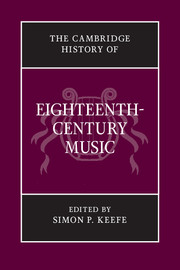Book contents
- Frontmatter
- PRELUDE
- PART I MUSIC FOR THE CHURCH
- INTERLUDE
- PART II MUSIC FOR THE THEATRE
- INTERLUDE
- PART III MUSIC FOR THE SALON AND CONCERT ROOM
- 16 Keyboard music from Couperin to early Beethoven
- 17 The serenata in the eighteenth century
- 18 Private music in public spheres: chamber cantata and song
- 19 Handel and English oratorio
- 20 The overture-suite, concerto grosso, ripieno concerto and Harmoniemusik in the eighteenth century
- 21 Concerto of the individual
- 22 Eighteenth-century symphonies: an unfinished dialogue
- 23 The string quartet
- POSTLUDE
- Appendix I Chronology
- Appendix II Institutions in major European cities
- Appendix III Personalia
- Index
- References
18 - Private music in public spheres: chamber cantata and song
from PART III - MUSIC FOR THE SALON AND CONCERT ROOM
Published online by Cambridge University Press: 28 March 2011
- Frontmatter
- PRELUDE
- PART I MUSIC FOR THE CHURCH
- INTERLUDE
- PART II MUSIC FOR THE THEATRE
- INTERLUDE
- PART III MUSIC FOR THE SALON AND CONCERT ROOM
- 16 Keyboard music from Couperin to early Beethoven
- 17 The serenata in the eighteenth century
- 18 Private music in public spheres: chamber cantata and song
- 19 Handel and English oratorio
- 20 The overture-suite, concerto grosso, ripieno concerto and Harmoniemusik in the eighteenth century
- 21 Concerto of the individual
- 22 Eighteenth-century symphonies: an unfinished dialogue
- 23 The string quartet
- POSTLUDE
- Appendix I Chronology
- Appendix II Institutions in major European cities
- Appendix III Personalia
- Index
- References
Summary
The eighteenth-century secular cantata confronts us with a nest of paradoxes. Though conceived at the beginning of the century as a kind of poetry, the cantata had for decades before been Italy’s dominant type of vocal chamber music. Though chamber music, the cantata shared with opera its use of alternating recitatives and arias for solo voice with continuo accompaniment. Though from 1700 bound up with particular social practices of the Italian literati, once disseminated abroad after 1700 the cantata merged and competed with indigenous chamber song – in the process becoming an ‘umbrella term’ for a wide range of musical forms, some of which were extremely popular. Though once so fêted, cantata music is virtually unknown to listeners today. This study will follow the chamber cantata from its birthplace in Italy through its absorption in France, England and Germany, tracking its metamorphoses as determined by local conditions of production and pre-existing traditions of song, and identifying the contributions of the genre’s chief exponents.
The legacy of the Accademia degli Arcadi
From around 1630, the secular cantata superseded chamber song and the madrigal in Italy. Although the form of the cantata changed around 1700, patterns in patronage and production followed those of the previous century. Cantatas were composed for an accademia or other privileged social forum, whose invited members shared views on philosophy, aesthetics and artistic trends. The term ‘accademia’ could carry four separate meanings: a fellowship under one patron or more; a gathering of fee-paying (traditionally male) members promoting current ideas; a meeting featuring musical performances and discussion; and the building where such meetings might take place.
- Type
- Chapter
- Information
- The Cambridge History of Eighteenth-Century Music , pp. 513 - 540Publisher: Cambridge University PressPrint publication year: 2009
References
- 1
- Cited by



